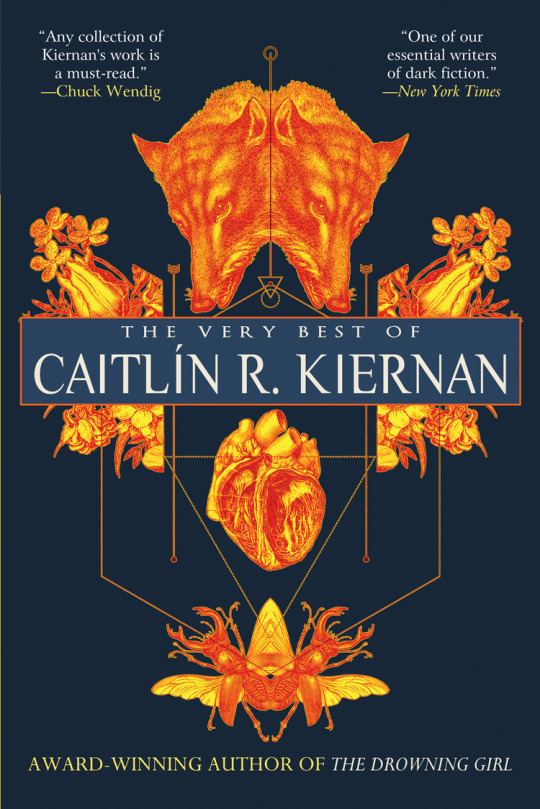THE VERY BEST OF CAITLÍN R. KIERNAN preview: “The Ammonite Violin (Murder Ballad No. 4)”
In celebration for the release of THE VERY BEST OF CAITLÍN R. KIERNAN, Tachyon presents glimpses from some of the volume’s strange and macabre tales by the “reigning queen of dark fantasy.”

The
Ammonite Violin (Murder Ballad No. 4)
by Caitlín R. Kiernan
“It
must be done precisely
as I have said,” he told the violin-maker, four months ago, when he
flew to Hotton to hand-deliver a substantial portion of the materials
from which the instrument would be constructed. “You may not
deviate in any significant way from these instructions.”
“Yes,”
the luthier replied, “I understand. I understand completely.” A
man who appreciates discretion, the Belgian violin-maker, so there
were no inconvenient questions asked, no prying inquiries as to why,
and what’s more, he’d even known something about ammonites
beforehand.
“No
substitutions,” the Collector said firmly, just in case it needed
to be stated one last time.
“No
substitutions of any sort,” replied the luthier.
“And
the back must be carved—”
“I
understand,” the violin-maker assured him. “I have the sketches,
and I will follow them exactly.”
“And
the pegs—”
“Will
be precisely as we have discussed.”
And
so the Collector paid the luthier half the price of the commission,
the other half due upon delivery, and he took a six a.m. flight back
across the wide Atlantic to New England and his small house in the
small town near the sea. And he has waited, hardly daring to
half-believe
that the violin-maker would, in fact, get it all right. Indeed—for
men are ever at war with their hearts and minds and innermost
demons—some infinitesimal scrap of the Collector has even hoped
that there would
be a mistake, the most trifling portion of his plan ignored or the
violin finished and perfect but then lost in transit and so the whole
plot ruined. For it is no small thing, what the Collector has set in
motion, and having always considered himself a very wise and sober
man, he suspects that he understands fully the consequences he would
suffer should he be discovered by lesser men who have no regard for
the ocean and her needs. Men who cannot see the flesh and blood
phantoms walking among them in broad daylight, much less be bothered
to pay tithes which are long overdue to a goddess who has cradled
them all, each and every one, through the innumerable twists and
turns of evolution’s crucible, for three and a half thousand
million years.
But
there has been no mistake, and, if anything, the violin-maker can be
faulted only in the complete sublimation of his craft to the will of
his customer. In every way, this is the instrument the Collector
asked him to make, and the varnish gleams faintly in the light from
the display cases. The top is carved from spruce, and four small
ammonites have been set into the wood—Xipheroceras
from Jurassic rocks exposed along the Dorset Coast at Lyme Regis—two
inlaid on the upper bout, two on the lower. He found the fossils
himself, many years ago, and they are as perfectly preserved an
example of their genus as he has yet seen anywhere, for any price.
The violin’s neck has been fashioned from maple, as is so often the
tradition, and, likewise, the fingerboard is the customary ebony.
However, the scroll has been formed from a fifth ammonite, and the
Collector knows it is a far more perfect logarithmic spiral than any
volute that could have ever been hacked out from a block of wood. In
his mind, the five ammonites form the points of a pentacle. The
luthier used maple for the back and ribs, and when the Collector
turns the violin over, he’s greeted by the intricate bas-relief he
requested, faithfully reproduced from his own drawings—a great
octopus, the ravenous devilfish of so many sea legends, and the maze
of its eight tentacles makes a looping, tangled interweave.
As
for the pegs and bridge, the chinrest and tailpiece, all these have
been carved from the bits of bone he provided the luthier. They seem
no more than antique ivory, the stolen tusks of an elephant or a
walrus or the tooth of a sperm whale, perhaps. The Collector also
provided the dried gut for the five strings, and when the
violin-maker pointed out that they would not be nearly so durable as
good stranded steel, that they would be much more likely to break and
harder to keep in tune, the Collector told him that the instrument
would be played only once and so these matters were of very little
concern. For the bow, the luthier was given strands of hair which the
Collector told him had come from the tail of a gelding, a fine grey
horse from Kentucky thoroughbred stock. He’d even ordered a special
rosin, and so the sap of an Aleppo Pine was supplemented with a vial
of oil he’d left in the care of the violin-maker.
For more info about THE VERY BEST OF CAITLÍN R. KIERNAN, visit the Tachyon page.
Cover by Hannes Hummel
Design by Elizabeth Story
